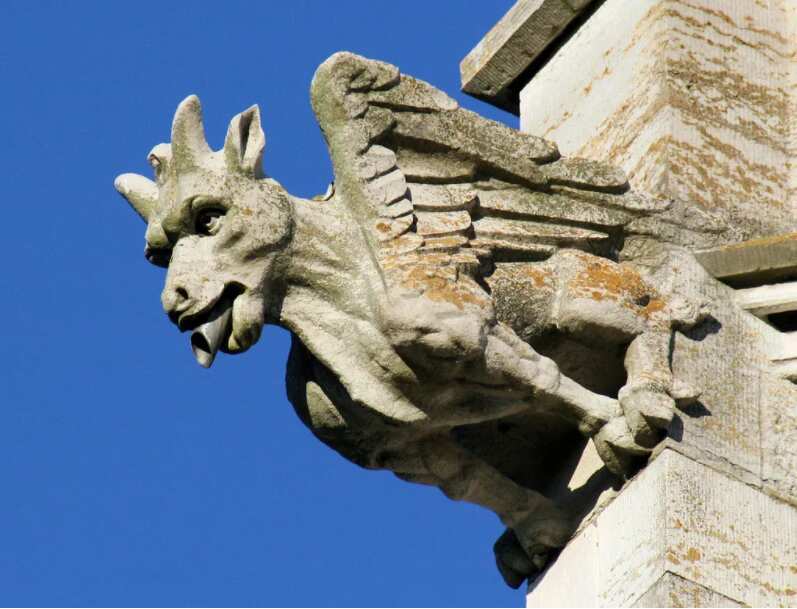Gargoyles mythology: What is a gargoyle and what does it symbolize?
Mythical figures are not new because they are as old as man himself. Most, if not all, traditional societies had mythical figures representing different things, whether spirits, gods, or even mere decorations. While such figures may represent a deeper meaning to their communities, as is the case with gargoyles mythology, they serve as tourist attractions to the rest of the world.
PAY ATTENTION: Click “See First” under the “Following” tab to see YEN.com.gh News on your News Feed!

Source: Instagram
Traditional societies relied on stories about monsters to give teachings, instil values and ward off evil. These stories inspired architects to incorporate the sculpture into structures like buildings and statues. However, since the statues tended to have a more religious meaning, they were primarily found in medieval Christian architecture.
What is a gargoyle?
The name originates from the French gargouille, which translates to gullet/throat or to swallow about the gurgling sound of water. They are decorative medieval architectural waterspouts, usual carvings of animals, humans, or even monstrous creatures.
Modern fantasy has reimagined the sculpture as ferocious monsters with stony skins that transform to stone during the day. One distinct feature of these creatures is that they tend to take the form of a twisted face or an animal hybrid. So it could be something like a creature with a lion's head, a goat's body, and a snake's tail.
Enjoy reading our stories? Join YEN.com.gh's Telegram channel for more!
Legend of the gargoyle
According to a French legend from the town of Rouen, a fearsome battle happened between a local bishop known as St. Romanus and a dragon named Gargouille. Gargouille was a creature that had bat-like wings, a long neck, and could breathe fire from its mouth.
The bishop singlehandedly defeated the dragon, captured it, and burned it. However, the fire could not consume its head because the heat of its fiery breath had long tempered it. So Bishop St. Romanus took the head and mounted it high on the church's wall to scare off evil spirits.
Gargoyles and grotesques
While gargoyles have a practical purpose of siphoning water, it does not explain why they are presented as scary creatures. To comprehend their secondary purpose, one has to explore the world of grotesques. Cyclopean are water spouts, but a grotesque is any frightening stone creature attached to a building.
The difference between gargoyles and grotesques is in the purpose they serve. A grotesque cannot serve the practical purpose of a gargoyle. This means that there has to be another motivation for carving such creatures.
The architectural function of a gargoyles

Source: Twitter
In architectural designs, cyclopean are stone-carved guardians mounted on one or more sides of a building. They usually have a spout design that conveys water from the roof away from the building's side. Its purpose is to stop the rainwater from eroding the mortar.
In big buildings, architects used to install several cyclopean to divide the flow of rainwater off the roof. By so doing, they minimized the potential damage from a rainstorm.
Gargoyle statues meaning and symbolism
Depending on its appearance, many meanings and symbols can be drawn from a gargoyle. The appearance-based symbolisms include:
- Disembodied heads: They usually represent figures from the 5th-century celts who were head hunters. People of the time worshipped the severed heads believing they had the power to make their hunting fruitful.
- Sex objects: The major theme of sex objects is fertility, and they were used to scare off evil spirits.
- Open mouth: Open mouths and protruding tongues symbolize devouring giants.
- Gender/species combinations: Ambiguous gender and species represented the chaotic nature of life. Such chaos emanated from life forms that don't fit into the known categories.
- Men with foliage: When a human head is entwined with foliage, it is usually a sign of divinity.
Are gargoyles protectors or monsters?
The debate rages on the gargoyle vs grotesque as people are divided about whether the mythical figures are protectors or monsters. These mythical figures usually have frightening appearances, but they are deemed to have powers of protecting buildings from evil spirits. In addition, they deter harm from reaching humans beings.
They were erected in holy places of worship to keep the devil and demons at bay. In addition, it was believed that because of the gargoyles' mythical powers, they were challenging to wound because of their stony skin, which makes them ideal guardians.
There are exceptions in which cyclopean are depicted as evil beings that eat humans. Other evil cyclopean act as vessels for demons, and they serve those who summon them. Such creatures are removed from buildings to avoid attracting harm.
Fearsome facts about gargoyles

Source: UGC
- They served a practical purpose as decorative water spouts that diverted water away from the walls to preserve them.
- They got their name from La Gargouille, a fearsome dragon that terrorized the people of Rouen.
- They were designed to instil fear in parishioners not to go against the church's teachings.
- Some were modelled to resemble creatures worshipped by pagan tribes hence bringing them to church.
- They date back to ancient Egypt.
- The famous Notre Dame gargoyles are fairly recent and not as old as the cathedral itself.
- Pittsburgh is one of the areas with the highest concentration of gargoyles as it has over 20 authentic gargoyles and hundreds of grotesques.
- Some gargoyles were fashioned to resemble their builders and church elders.
- During the Chapel of Bethlehem restoration in France, its crumbling gargoyles were replaced by Gremlins.
Frequently asked questions
- What is a Gargoyle? It is a decorative medieval architectural waterspout that is usually a carving of an animal, human, or even monstrous creature.
- Are gargoyles real? They are real because they are stone statues to act as waterspouts and scare away evil spirits.
- What are the powers of gargoyles? They watch over the city at night and ward off evil spirits and demons.
- Are gargoyles fallen angels? They are just statues made of stone. Celestial cyclopean depict beings of celestial origin with wings, but they are not fallen angels.
- Do gargoyles protect you? According to a French legend, they protect against evil and harmful spirits.
- What do gargoyles symbolize? Depending on their appearance, they can symbolize creatures from hell, part human and part monster, whose purpose is to scare away evil spirits.
- Are gargoyles good or evil? They are in both spectrums. Good ones protect you from evil, while bad cyclopean act as vessels for demons and serve those who summon them.
Gargoyles mythology may be represented by the decorative waterspouts found in medieval churches, but they meant more than just decorations. The carvings were like guardians that protected the people from evil spirits.
Yen.com.gh shared an interesting article about Adinkra symbols. Adinkra is a cotton cloth produced in Ghana and Côte d'Ivoire which has traditional Akan symbols stamped upon it.
The adinkra symbols represent popular proverbs and maxims, record historical events, and express particular attitudes or behaviour related to depicted figures. It is one of several traditional clothes produced in the region.
Our manifesto: This is what YEN.com.gh believes in
Source: YEN.com.gh






